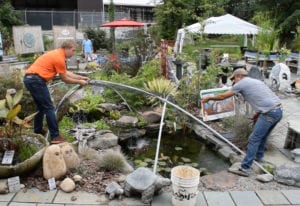
Who’s up for a campfire next to the pond?
October is a beautiful month for enjoying a few last warm days outdoors before the end of the season. Your fish are likely slowing down this month, hardy plants are going dormant and tropicals are showing off their last flowers. (Check out Tip No. 2 below for more information about fall plant care.)
Wondering what you can do to get your pond ready for the cooler weather ahead? Read our October Deep-Dive for a guide to fall and winter pond care.
3 Tips for October Pond Care
1. Switch to Cold Water Fish Food
 We typically switch our fish over to Cold Water Fish Food in October here in southcentral PA.
We typically switch our fish over to Cold Water Fish Food in October here in southcentral PA.
Cold Water Fish Food is easier to digest than summer formulas, making it perfect for the times of year when your fish’s digestive systems are slowing down or just waking up for the season. It includes wheat germ, stabilized vitamin C and other nutrients that make for happy, healthy fish.
> Find Cold Water Fish Food at our Online Store
October is also when you’ll want to start decreasing the amount of food you give your fish. Gradually cut back the size and frequency of feedings until the water temperature drops below 50-55 degrees, then stop feeding entirely.
2. Get plants ready for winter
Remove any tropical plants that you want to preserve before the nighttime temperature drops below freezing. Anything you keep in the pond past that point will die and need to be removed.
Hardy plants don’t need much prep going into winter. You can cut back tall plants if you want to keep the pond tidy or need to install netting, or you can leave them be and let the birds and wildlife use them for winter food and shelter. (Make sure to cut above the water line for most plants; this is especially important for lotus).
By the way – you don’t need to “sink” your waterlilies in winter. Hardy lilies will generally survive the winter just fine in the same water depths where they spend the summer (about 12 to 30 inches deep).
3. Switch to weekly doses of Cold Water Beneficial Bacteria
 Beneficial Bacteria is our go-to water treatment for keeping water crystal-clear and fish happy and healthy.
Beneficial Bacteria is our go-to water treatment for keeping water crystal-clear and fish happy and healthy.
Bacteria do lots of helpful things for your pond, including consuming harmful ammonia and algae-causing nitrites. For best results, apply bacteria at least once a week throughout the season, or install an Automatic Dosing System that will do the work for you.
Pond Bacteria comes in lots of forms – so how do you know which one you need?
Just follow this guide:
- For water below 50 degrees: Cold Water Bacteria (Available at Splash)
- For water above 50 degrees: Beneficial Bacteria (Available at Splash)
- For new ponds, recently cleaned ponds or springtime ponds above 40 degrees: Pond Starter Bacteria (Available at Splash)
- For Automatic Dosing Systems: Maintain for Ponds Autodoser Pouch (Available at Splash)
In October, you’ll likely be ready to switch to Cold Water Bacteria.
Liquid Beneficial Bacteria comes in an easy-to-use pump-top container. If you buy an 8 oz, 16 oz, or 32 oz bottle, simply add one pump of bacteria per 100 gallons of water in your pond once a week. If you buy a gallon bottle, use one pump per 600 gallons.
(Dry forms of bacteria are also available. See your container for dosing instructions.)
To Calculate Pond Size in US Gallons: Length (in feet) x Width (in feet) x Average Depth (in feet) x 7.48
All of the Beneficial Bacteria products listed above are completely safe for fish and plants – making them a great alternative to potentially harmful algaecides.
October Deep-Dive
How to Prepare Your Pond for Fall & Winter

Fall is the perfect time to relax by your pond and appreciate the cool weather and warm autumn colors.
It’s also time to decide how you’ll get your pond life through the winter.
Most fish will survive a Pennsylvania or Maryland winter with few issues if you take the proper precautions. Your pond equipment – pump, biofilter and skimmer – will also make it through with proper planning.
Start getting your pond ready for the changing seasons in early to mid September. Your fish, plants and equipment will thank you come springtime.
At a Glance: Fall & Winter Pond Prep
- Clean In and Around the Pond
- Install a Leaf Net
- Remove the Leaf Net
- Decide If You Want to Shut Down the Pond for the Winter
